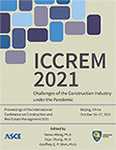Study on Multi-Level Safety Risk Assessment of Two-Line Three-Step Construction of Long-Span Shallow Buried and Hidden Excavation Tunnel
Publication: ICCREM 2021
ABSTRACT
In the construction of long-span shallow buried and hidden excavation tunnel, the two-line three-step construction can avoid the risk caused by the structural system transformation during the demolition of temporary support. However, the two-line three-step method is applied to the underground tunnel construction technology is complicated, the stress system is complex, and the risk sources are numerous. Especially when crossing the soft and complex stratum and shallow tunnel buried and hidden excavation, the difficulty of tunnel deformation control and construction risk are significantly improved. To improve the safety risk control level in the construction process, the paper analyzes the risk factors of the two-line three-step construction of the long-span shallow buried and hidden excavation tunnel, carries out multi-level identification and fuzzy comprehensive evaluation of the risk factors, and determines the major risk sources. The results show that the construction process is a major and high-risk behavior, and the main risk is from management risk and technical risk, among which personnel management, safety education, and safety supervision are the biggest risk sources, and prevention work should be done for important risk points. The results of safety risk assessment have a high-reference value for the safety management practice of the two-line three-step construction of long-span shallow buried and hidden excavation tunnel.
Get full access to this article
View all available purchase options and get full access to this chapter.
REFERENCES
Cao, Z. C., and Liu, Y. S. (2017). “Research on the competency evaluation of engineering project manager based on principal component analysis and analytic hierarchy process.” Journal of Engineering Management, 31(3), 114–118. (in Chinese).
Fan, D. D., Yang, H. M., Zhang, B. B., and Huo, F. Z. (2020). “Fire safety risk assessment of subway stations based on fuzzy comprehensive evaluation method.” Industrial Safety and Environmental Protection, 47(03), 43–46+50. (in Chinese).
Goumrasa, A., Guendouz, M., Guettouche, M. S., and Belaroui, A. (2021). “Flood hazard susceptibility assessment in Chiffa wadi watershed and along the first section of Algeria North-South highway using GIS and AHP method.” Applied Geomatics, 1–21.
Günen, M. A. (2021). “Determination of the suitable sites for constructing solar photovoltaic (PV) power plants in Kayseri, Turkey using GIS-based ranking and AHP methods.” Environmental Science and Pollution Research International, 1–16.
Haider, H., Alkhowaiter, M. H., Shafiquzzaman, M. D., Alresheedi, M., AlSaleem, S. S., and Ghumman, A. R. (2021). “Source to tap risk assessment for intermittent water supply systems in arid regions: an integrated FTA-Fuzzy FMEA methodology.” Environmental Management, 67(2), 324–341.
Maceika, A., Bugajev, A., Šostak, O. R., and Vilutienė, T. (2021). “Decision tree and AHP methods application for projects assessment: a case study.” Sustainability, 13(10), 1–33.
Pamucar, D., Ecer, F., and Deveci, M. (2021). “Assessment of alternative fuel vehicles for sustainable road transportation of United States using integrated fuzzy FUCOM and neutrosophic fuzzy MARCOS methodology.” Science of the Total Environment, 788, 147763.
Peng, X. J., Cao, Z. X., Peng, Y. Y., Li, Y. P., and Ling, T. (2020). “Application of double sidewall guide pit method in urban subway bored tunnels.” Engineering Construction, 52(2), 47–53. (in Chinese).
Tang, Y. Y., Wu, X. G., Chen, H. Y., Tao, Y. Y., Wang, H., Zeng, T. M., and Zhang, L. M. (2019). “Evaluation of floating risk of shield tunnel segments based on Cloud model and DS evidence theory.” Tunnel Construction, 39(12), 2011–2019. (in Chinese).
Tian, H. W. (2015). Study on the Risk Evaluation of Shield Tunnel Adjacent Existing Buildings Construction. Lanzhou Jiaotong University, Lanzhou, China, 1–93. (in Chinese).
Wang, J., Hu, D., Wu, H., Wang, M., and Liu, D. (2020). “Risk assessment in construction of small-diameter deep drainage tunnel.” China Safety Science Journal, 30(6), 113–120. (in Chinese).
Wang, Y. (2017). “Study on risk evaluation of expressway operation enterprises based on AHP-Fuzzy evaluation.” Journal of Highway and Transportation Research and Development, 34(4), 154–158. (in Chinese).
Wei, D. (2018). “Risk assessment for subway construction based on fault tree analysis and analytical hierarchy process: a case study of destabilization of pit supporting structure of tunnel shaft.” Safety and Environmental Engineering, 25(1), 100–104. (in Chinese).
Wu, M., and Huang, Z. (2020). “Construction quality control technology of inverted arch of single-tube double-track railway tunnel.” Tunnel Construction, 40(S1), 278–287. (in Chinese).
Xiao, M., Chang, D., Li, J., Wang, M., and Nie, Z. (2020). “Stress analysis of integral trolley of arch crown in the construction of two lining and three step method for large-span tunnel.” Construction Technology, 49(S1), 796–798. (in Chinese).
Yang, S., and Sun, T. (2021). “Evaluation of metro emergency management capability based on fuzzy comprehensive evaluation method: a case study of Nanjing metro line 1.” Journal of Liaoning University of Technology (Natural Science Edition), 41(3), 195–200. (in Chinese).
Zhang, K. F., Guo, J., Zeng, B., and Zhu, W. (2021). “Research on state evaluation method of transformer based on optimal weight and fuzzy comprehensive evaluation.” Engineering Journal of Wuhan University, 54(6), 563–570. (in Chinese).
Zhang, Y., and Qiao, Y. (2020). “Study on the spatial effects of different types of environmental regulations on industrial structure upgrading: an empirical study based on spatial Durbin model analysis.” Ecological Economy, 37(6), 66–73. (in Chinese).
Zhou, B. S. (2018). “Optimized CRD construction techniques for a super-shallow bored tunnel.” Modern Tunneling Technology, 55(4), 186–190. (in Chinese).
Zhou, Z., and Zheng, L. (2008). “The research of highway construction risk assessment based on chaos neural network.” Highway Engineering, (1), 51–54+58. (in Chinese).
Information & Authors
Information
Published In
Copyright
© 2021 American Society of Civil Engineers.
History
Published online: Dec 9, 2021
Authors
Metrics & Citations
Metrics
Citations
Download citation
If you have the appropriate software installed, you can download article citation data to the citation manager of your choice. Simply select your manager software from the list below and click Download.
